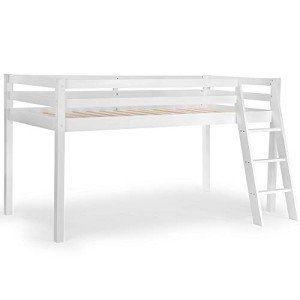How To Resolve Issues With Bunk Bed For Kids

The Ultimate Guide to Bunk Beds for Kids: Safety, Styles, and Solutions
Bunk beds have long been a popular choice among parents looking for to optimize space in their kids's bedrooms. With benefits that exceed their compact design, bunk beds use an enjoyable and practical sleeping arrangement while motivating brother or sister bonding and promoting creativity. In Bunk Beds For Teens , we check out various aspects of bunk beds for kids, consisting of safety factors to consider, various designs available, and suggestions for selecting the right one for your family.
Why Choose Bunk Beds?
Bunk beds are designed to stack one bed on top of another, making use of vertical space to produce more space for play and storage. They are particularly beneficial for households with numerous children or minimal bedroom space. Furthermore, they offer an adventurous sleeping environment that children frequently enjoy.
Secret Advantages of Bunk Beds:
- Space-saving style: Ideal for little rooms or shared areas.
- Economical: Often more budget friendly than purchasing 2 separate beds.
- Motivates social interaction: Promotes bonding amongst siblings or good friends.
- Flexible choices: Available in various styles and configurations to suit any space design.
Safety First: Essential Considerations
When selecting a bunk bed for kids, security must be the leading priority. The following functions are crucial for ensuring a safe sleeping environment:
Important Safety Features:
- Sturdy Construction: Ensure that the bed frame is made from long lasting materials such as solid wood or metal.
- Guardrails: Bunk beds should have guardrails on both sides of the upper bunk to prevent falls.
- Ladder Safety: A tough, integrated ladder or stairs with anti-slip rungs is essential for safe access to the top bunk.
- Weight Limit: Check the manufacturer's weight limit capability for both the leading and bottom bunk.
- Bed mattress Size: Use the proper mattress size as specified by the bed maker to guarantee a snug fit within the bed frame.
Security Tips for Parents:
- Monitor Sleep Habits: Teach children the value of not using or jumping off the bunk beds.
- Age Appropriateness: Generally, the upper bunk is suitable for kids aged 6 and older.
- Regular Inspections: Periodically look for any loose bolts, screws, or structural damage.
Styles of Bunk Beds
Bunk beds are available in a range of designs, allowing moms and dads to pick one that matches their kid's room design while conference particular needs. Below are some popular styles:
Popular Bunk Bed Styles:
- Traditional Bunk Beds: Simple and classic designs made of wood or metal with no additional features.
- Loft Beds: Features a raised top bunk with space underneath for a desk, play location, or extra storage.
- L-Shaped Bunk Beds: Arranged in an L-shape, often ideal for corner areas and can have additional storage options.
- Twin over Full Bunk Beds: A twin bed on the top and a bigger full-sized bed on the bottom, accommodating children or teens of numerous ages.
- Triple Bunk Beds: Designed to fit three beds in a single footprint, suitable for bigger households or slumber parties.
A Comparison of Bunk Bed Styles
| Bunk Bed Style | Description | Best For |
|---|---|---|
| Traditional | Classic style with two stacked beds | Requirement bedroom setups |
| Loft Bed | Raised bed with functional space underneath | Research or play areas |
| L-Shaped | Bunk beds set up in an L-shape | Corner spaces |
| Twin over Full | Twin bed on top, full bed listed below | Different age siblings |
| Triple Bunk | Three stacked beds | Big households or slumber parties |
Choosing the Right Bunk Bed
When looking for the best bunk bed, consider the following elements to ensure you make a notified decision:
Key Factors to Consider:
- Room Size: Measure the space measurements to identify the proper size and height of the bunk bed.
- Child's Age: Consider the age of your kid(ren) when selecting a style and security features.
- Performance: Think about how much storage or play space you require and whether the bunk bed should serve extra functions.
- Spending plan: Set a budget plan that consists of not only the bunk bed however also the required mattress and accessories like bedding or security gates.
Frequently Asked Questions About Bunk Beds for Kids
1. What age is appropriate for a child to sleep in the top bunk?
Typically, children aged 6 and older should have the ability to safely oversleep the leading bunk, though you ought to constantly consider your kid's maturity level.
2. Are bunk beds safe for young children?
It is not advisable for young children or very children to oversleep the leading bunk due to the risk of falling.
3. How do I keep the bunk bed?
Check the bed routinely for any signs of wear and tear, tightening screws, and cleaning the bed mattress to make sure prolonged security and sturdiness.
4. Can I convert a bunk bed into 2 different beds?
Many bunk beds are designed to be convertible, allowing you to separate the beds when needed. Inspect the maker's specs before purchasing.
5. How can I make the most of space in a bunk bed room?
Utilize under-bed drawers, racks, or lofted styles to create extra storage solutions in a room with a bunk bed.
Bunk beds offer a wonderful blend of enjoyable, performance, and space-saving energy, making them a best choice for young households. By thinking about security functions, various designs, and useful aspects such as room size and age suitability, moms and dads can choose the perfect bunk bed for their kid's requirements. With the best choice, bunk beds can change a bedroom into a magical space that motivates play, imagination, and bonding amongst siblings. Always keep in mind to prioritize safety and maintenance to maximize this special sleeping plan.

